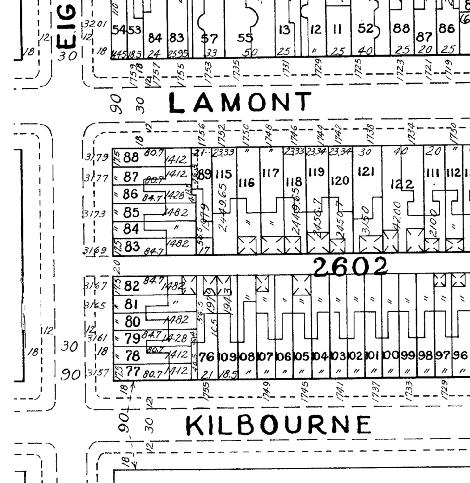What's not often realized is that this setback is caused by the legal width of the streets, the "right of way", being considerably greater than the actual, physical width of the street, plus sidewalk. When this city was first laid out, the plans called for very wide streets. But the city didn't build the streets to the full legal width, leaving unused right of way alongside those streets. The District retains legal title to the space, but puts it "under the immediate care and keeping of the owners or occupants of the premises abutting on the public parking" (DC Municipal Regulations Title 24, par.102.1). This unused District space is called a "parking" because it's supposed to be maintained in the manner of parkland (not because anyone can park cars on it).

This space becomes, in ordinary use, "front yard" for the adjacent property owner. Nothing on the ground shows where the owner's property ends and the DC-owned "parking" begins. Essentially, measure 18 feet from the closest edge of the sidewalk, and that's the actual property line.
Make such a measurement along the houses shown in the photograph, and you'll find that those front-yard gardens are exactly 10 feet deep. The remaining eight feet of the "parking" is the land on which the front porches are built. The law allows such construction on "public space", as "projections", projecting up to eight feet into the parking. Hence the rule for Mount Pleasant homes along these 90-foot rights-of-way is to have a ten-foot front yard, and an eight-foot front porch.
That's all "public space", of course, a term that is misleading, because this space is not open to the public. No one can come into a front yard and make use of it for, say, a picnic, arguing that it is "public space", and hence open to use by the public. No one can intrude onto a front porch and make himself at home, simply because that porch is built on "public space". The space is owned by the District, not by the adjacent property owner, but that doesn't make it open for use by the public.

In Mount Pleasant, these streets have 90-foot rights-of-way, and hence 18-foot-deep "parkings":
Kenyon Street, from Adams Mill Road to 17th Street
Irving Street, from Kenyon intersection to 17th Street
17th Street, from Irving Street to Lamont Street
18th Street, from Irving Street to Park Road
19th Street, from Kenyon Street to Park Road
Park Road, from 18th Street to Walbridge Place
Kilbourne Place, from 19th Street to 17th Street
Other streets are generally 60-foot rights-of-way. The roadbed remains 30 feet wide, but sidewalks are reduced to 10 feet in width, leaving parkings about five feet in width. Hence, along such streets -- e.g., Monroe, Newton, Hobart -- the houses tend to be closer to the street, and only the front edge of the yards, three to five feet, is "public space". That remains enough, of course, that front-yard fences are on public space, are subject to the public space regulations, and require public-space permits.
Return to home
Some of the regulations
applicable to Mount Pleasant's "parkings":
102.3 No hedges shall be
planted on public parking without a permit from the District. The same fee
shall be charged as for parking fences.
102.4 Hedges on parking
shall not exceed three feet (3 ft.) in height, nor project more than six
inches (6 in.) over the sidewalk. On corner properties, if hedges are
placed at the back of the sidewalk, they must be planted not more than ten
inches (10 in.) above the sidewalk grade.
103.1 After obtaining a
permit from the District, the owners or occupants of land abutting a
public parking may enclose the parking with any of the
following:
(a) Walls of an
approved type not exceeding three feet by six inches (3 ft. x 6 in.) in
height;
(b) Wooden fences of colonial
design of an approved type not exceeding three feet by six inches (3 ft. x
6 in.) in height, with square, rectangular, or round posts and rails; with
or without square, rectangular or round pickets extending through the
rails; or
(c) Open fences of an approved type
not less than three feet (3 ft.) or more than three feet by six inches (3
ft. x 6 in.) in height, constructed of iron, ornamental wire, or woven
wire, and having top and bottom string pieces.
103.2 No permit shall be issued for, and it shall be unlawful to maintain, a sharp-pointed or spear-headed type of fence that has uppermost points or prongs that are less than one-half inch (1/2 in.) in diameter.
103.3 Walls and fences of a height greater than three feet six inches (3 ft. x 6 in.) shall be permitted only when specifically approved by the Mayor.